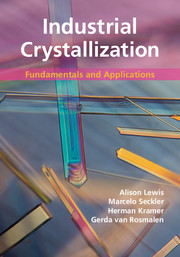Book contents
- Frontmatter
- Contents
- Nomenclature
- Industrial crystallization in practice: from process to product
- 1 Thermodynamics, crystallization methods and supersaturation
- 2 Characterization of a crystalline product
- 3 Basic process design for crystallization
- 4 Nucleation
- 5 Crystal growth
- 6 Agglomeration
- 7 The population balance equation
- 8 Batch crystallization
- 9 Measuring techniques
- 10 Industrial crystallizers
- 11 Precipitation and anti-solvent crystallization
- 12 Melt crystallization
- 13 Additives and impurities
- 14 Polymorphism
- Index
- References
13 - Additives and impurities
Published online by Cambridge University Press: 05 July 2015
- Frontmatter
- Contents
- Nomenclature
- Industrial crystallization in practice: from process to product
- 1 Thermodynamics, crystallization methods and supersaturation
- 2 Characterization of a crystalline product
- 3 Basic process design for crystallization
- 4 Nucleation
- 5 Crystal growth
- 6 Agglomeration
- 7 The population balance equation
- 8 Batch crystallization
- 9 Measuring techniques
- 10 Industrial crystallizers
- 11 Precipitation and anti-solvent crystallization
- 12 Melt crystallization
- 13 Additives and impurities
- 14 Polymorphism
- Index
- References
Summary
Why this chapter is important
Although additives and impurities are often present in relatively small concentrations, even trace amounts can have a significant effect on the crystallization process as a whole. Thus, when working in “real” crystallization processes, understanding the influence of additives and impurities is very important.
Although the topic of additives and impurities has been the subject of extensive study by many different researchers, it is still a difficult area, partly because the field itself is very broad and diverse, but also because there are so many different applications in which additives and impurities play an essential role (Meenan et al., 2002, Sangwal, 2007).
Application and occurrence
For many centuries long chain organic additives with molecular weights of a few thousand daltons were used in particle formation processes as, for example, dispersants, flocculants and flotation agents. They were generally added, at dosages below 1 wt%, after the particles were formed.
However, in this chapter,we will discuss the role and design of additives and impurities that are present during crystallization at low dosages from parts per billion (ppb) to, at most, a few wt%. Highly charged metal ions can influence the crystallization process at only ppb concentrations, polymers at <1 wt% concentrations, whereas monomers must be present at the wt% level in order to have an influence.
Because of their low concentrations, additives do not influence the supersaturation (by coordination of ions in solution, for example), but only have the ability to act upon the crystal surface. Such additives are, for example, growth inhibitors, habit modifiers, anti-caking agents (applied as after-treatment) or templates for preferred nucleation.
Since impurities (i.e. additives that are unintentionally present) that can originate from the raw material, or can be formed as by-products during synthesis of the product, often have similar effects as additives on the crystallization process, they are also considered in the same chapter.
The solvent can also have similar effects on the growth kinetics and the shape of the crystals, as will be discussed.
- Type
- Chapter
- Information
- Industrial CrystallizationFundamentals and Applications, pp. 284 - 302Publisher: Cambridge University PressPrint publication year: 2015



